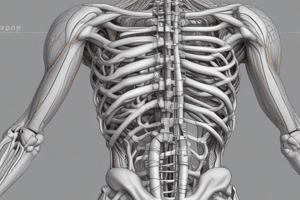Podcast
Questions and Answers
Which fiber type is characterized by being fatigue resistant and having a higher number of mitochondria?
Which fiber type is characterized by being fatigue resistant and having a higher number of mitochondria?
- Type 1 fiber (correct)
- Type 2B fiber
- Type 2A fiber
- Type 2X fiber
What type of fascicle orientation consists of fascicles that are aligned parallel to the long axis of the muscle?
What type of fascicle orientation consists of fascicles that are aligned parallel to the long axis of the muscle?
- Convergent
- Circular
- Parallel (correct)
- Pennate
Which of the following statements about Type 2 fibers is true?
Which of the following statements about Type 2 fibers is true?
- Type 2A fibers are intermediate between Type 1 and Type 2. (correct)
- Type 2 fibers do not produce large forces.
- Type 2X fibers are efficient in energy use.
- Type 2 fibers are primarily aerobic.
Which fascicle orientation is characterized by having a central tendon running through the muscle?
Which fascicle orientation is characterized by having a central tendon running through the muscle?
What does a myotome represent in the human muscular system?
What does a myotome represent in the human muscular system?
Match the following spinal levels with their corresponding muscle groups:
Match the following spinal levels with their corresponding muscle groups:
Flashcards are hidden until you start studying
Study Notes
Fascicle Orientation
- Parallel: Muscle fibers run in the same direction as the muscle's long axis, found in most skeletal muscles.
- Circular: Muscle fibers arrange in a circular pattern, like the sphincter muscles.
- Convergent: Muscle fibers converge from a wide origin to a narrow insertion, examples include the pectoralis major muscle.
- Pennate: Muscle fibers attach to a central tendon running through the muscle, known for generating high force but limited movement.
Fiber Type
- Slow Twitch (Type 1):
- Fatigue resistant and rely on aerobic metabolism.
- High in mitochondria and myoglobin for oxygen storage.
- Fast Twitch (Type 2):
- Fatigue quickly but produce greater force.
- Type 2X: Produce the most force but are inefficient and rely heavily on anaerobic metabolism.
- Type 2A: Intermediate between Type 1 and Type 2X in both fatigue resistance and force production.
Myotome
- A group of muscles innervated by a single spinal nerve root.
Spinal Nerve Root Innervation of Muscles
- C5 - Innervates the elbow flexors, responsible for bending the elbow.
- C6 - Controls the wrist extensors, allowing the wrist to move back, or extend.
- C7 - Innervates the elbow extensors, allowing for straightening of the elbow.
- C8 - Governs the finger extensors, enabling extension of the fingers.
- T1 - Innervates the intrinsic hand muscles, responsible for fine motor movements within the hand.
- L2 - Innervates the hip flexors, important for flexing the hip.
- L3 - Controls the knee extensors, essential for straightening the knee.
- L4 - Innervates the ankle dorsiflexors, allowing for dorsiflexion, or pointing the toes up.
- L5 - Controls the long toe extensors, which are involved in extending each toe individually.
- S1 - Innervates the ankle plantar flexors, crucial for plantar flexion, or pointing the toes down.
Studying That Suits You
Use AI to generate personalized quizzes and flashcards to suit your learning preferences.




